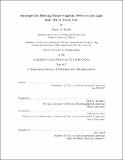Strategies for meeting future capacity needs on the light rail MBTA Green Line
Author(s)
Sindel, David A
DownloadFull printable version (31.87Mb)
Other Contributors
Massachusetts Institute of Technology. Department of Civil and Environmental Engineering.
Advisor
John P. Attanucci and Frederick Salvucci.
Terms of use
Metadata
Show full item recordAbstract
The MBTA Green Line in the Boston metropolitan area is the busiest light rail system in the United States. Aging infrastructure and vehicles, a soon-to-be-constructed line extension, and the potential for 40% ridership growth by mid-century will tax already inconsistent service. But in this challenge lies opportunity: a potential full-fleet replacement and accompanying infrastructure upgrades would remove constraints which have long affected operations and vehicle selection. Service evaluation and operations planning including frequency assignment, scheduled setting, and vehicle allocation are relatively well-understood problems for simple public transit lines. However, complex systems like the Green Line - those with multiple overlapping service patterns or branches sharing a trunkline - often present a transit planner with multiple tradeoffs and difficult decisions. Similarly, selection of appropriate rolling stock to help meet increasing capacity requirements is more difficult on a legacy system with physical constraints. Detailed analysis of various automated data collection sources can be used to assist medium-term and long-term planning decisions for these complex systems. This thesis offers a sequential approach to improving the Green Line in that context. Analysis before and after schedule changes in spring 2016 (including the removal of three-car trains) shows that overall capacity increased and passenger waiting times decreased. However, this is largely the partial reversal of service deterioration since 2010, rather than significant longterm improvement. The development of a linear optimization model for determining service frequency and vehicle allocation provides a method to incorporate observational data into evaluation of alternate service scenarios. Analysis of potential rolling stock models based on capacity and physical characteristics indicates that current light rail product lines from four manufacturers can be viable for future Green Line use, although some modifications and infrastructure upgrades will be necessary to meet long-term capacity needs. Although the specific details of this case study are particular to the Green Line, the process should be broadly applicable to other complex branched transit systems.
Description
Thesis: S.M. in Transportation, Massachusetts Institute of Technology, Department of Civil and Environmental Engineering, 2017. This electronic version was submitted by the student author. The certified thesis is available in the Institute Archives and Special Collections. Cataloged from student-submitted PDF version of thesis. Includes bibliographical references (pages 241-246).
Date issued
2017Department
Massachusetts Institute of Technology. Department of Civil and Environmental EngineeringPublisher
Massachusetts Institute of Technology
Keywords
Civil and Environmental Engineering.